Crack-Me Writeup - SnD Reversing Tutorial #2
The objective of this Crack-Me is to get the flag/ the success message by either validating a license key from a file or patching the execution flow of the program. You may use any other methods.
Challenge Description:
- Name: Search and Destroy (SnD): Reversing Tutorial by Lena #2
- Difficulty: Easy
- Category: Crack Me, assembly
- Rating: -
- Host: Search and Destroy, Lena
A personal note
At the time of writing of this write-up, I had moved from Windows to Linux OS. Some resources were not available. However, necessary resources were included to compensate. The pictures/screenshots may look different but please use memory addresses as a reference for navigating in between them.
Tl;dr:
Summary
The licensing algorithm checks the Keyfile.dat file for a valid license key. A license key that complies with the following conditions would pass the algorithm:
- The license key should be at least 16 Bytes long (16 Characters).
- Have a minimum of 8(47h or “G”), before any zeroes in the license key.
A valid license key: “GGGGGGGGGG000000”.
The license validation algorithm in pseudo python:
ESI = 0
EBX = 0
for each_letter/character in licenseKey:
if letter == 0:
if ESI < 8:
JUMP [Invalid LicenseKeyMessage]
elif ESI >=8:
JUMP [Valid LicenseKeyMessage]
if letter != 0x47 or "g":
EBX = EBX + 1
elif letter == 0x47 or "g":
ESI = ESI + 1Solving the Crack-Me
Solving a simple Crack-Me challenge like this can be achieved using several methods. Methods such as patching the execution flow of the program by altering the operation codes (opcode) and/or devising a license key based on the licensing algorithm. This write-up will focus on the latter option.
In devising a license key the structure and as well as relevant parameters needs to be considered. These include:
- License key length/size
- Content type: made up of numbers, letters or both (alphanumeric) and/or special characters e.g “!@#$…”
- if the key is stored in a file, what is the file name?
To gather such information about the license key its required to identify how the software interacts with it. In a real scenario, a commercial software may validate, save and re-validate the licensing information when it is activated and re-launched. Programs have many options when it comes to saving data/user licensing information, these include:
- Save data to the Registry (in case of Windows OS).
- Write to a file.
- Handle licensing information using a remote server.
This is a simple Crack-Me challenge, thus it would not handle its licensing data using a remote server. Assuming it is is handled locally, the remaining two options are saving the licensing data in the registry or in a file.
CreateFileA
Understanding how the software interacts with the OS helps in identifying how the licensing data is stored. Programs do not have direct access to the storage device for reading and writing data and thus it will need to go through the Kernel. In this scenario, the kernel is simply an interface that takes in write/read requests and manages the underlying low-level operations. To access the kernel for reading/writing operations, the Windows 32 (win32) API library allows users to call and utilize its predefined functions and classes. The win32 API library documentation can be found:
- View on Microsoft Developers Network
- Download Win32 API documentation from Laurence Jackson website
- Download Win32 API documentation from this blog (Thanks to Laurence Jackson)
If a program needs to write to and read from a file, it needs to call a predefined win32 function. In this case the “CreateFile” function. We can use this as a signature to find whether if the license key is being stored in a file or a registry since different functions handle different operations. We can search the disassembled CrackMe executable for this call by either:
- Reading and finding it manually or,
- Utilizing available plugins.
If you are using Olly Debugger there are some plugins that can help with this, such as APIFinder by Tomisslav Pericin. There are plugins available for other debuggers, you will need to do a google search. For example debuggerName API finder/set breakpoint.
If we search the disassembled CrackMe executable for calls to CreateFile function. We come up with a call to the “CreateFileA” instead of “CreateFile”. The “CreateFileA” is the American National Standards Institute(ANSI) version of “CreateFile”, which is a standard for the character encoding system. The characters encoded using ANSI standard are 1 byte long compared to the 2 bytes long Unicode encoded characters. Meaning the ANSI standard has a smaller characterset compared to Unicode (Akhgari, 2008).
The Win32 API documentation for “CreateFileA” states that it “Creates or opens a file…(and) The function returns a handle that can be used to access the file…”. The call to “CreateFileA” function is made accordingly (in the red box) refer to figure 1:
Figure 1: CreateFileA - Opening “Keyfile.dat” and Returning a file handle
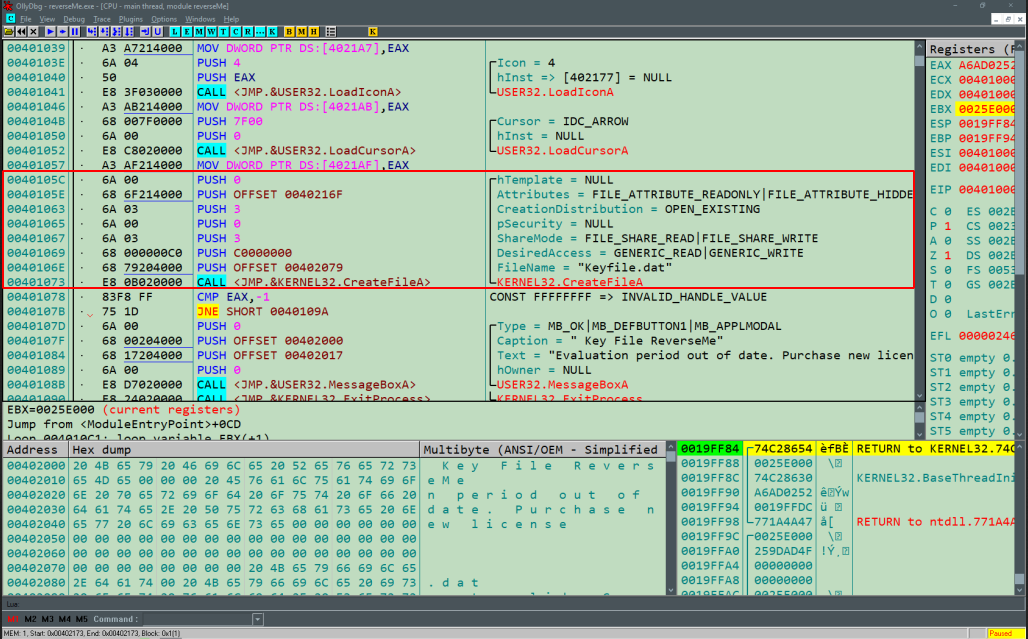
In the screenshot above, we can see a call to CreateFileA. Before the call, parameters for that function are pushed onto the stack. Comparing it to the API documentation, we can see that the function parameters are passed in reverse order. Chen 2004, from MSDN blogs, describes that parameters are passed in reverse order (in reference to CDECL calling convention)”…so that the first parameter is nearest to top-of-stack…”. Thinking back to how the stack works, it does sort of make sense?, the Last element In would be the First to be Out (LIFO) (Wikipedia, 2018). If you read the API reference for CreateFileA we can see that in order to create a file we need to pass several parameters, among them is a file name (lpFileName). The filename that is passed to this particular call is “keyfile.dat”. This filename confirms that the license key is being stored locally and in this file. The CreateFileA API reference mentions that it returns either a file handle or a “-1” using the EAX register. Meaning, if the CreateFileA function was able to open “Keyfile.dat”, it would return the handle to that file in the EAX register and if it did not, it would return “-1”.
Next, there is a compare (CMP) instruction , taking the EAX register and “-1” as operands. It compares the content of the operands, specifically it performs a logical AND operation (please refer to an X86 Opcode manual). Based on the result of the operation, flags such as the ZF(Zero), SF(Signed) and PF(Parity) flags are set in the EFLAGs register.
In reference to the mentioned x86 opcode manual (JCC section), see figure 2, the JNE - Jump if Not Equal (opcode 75) instruction jumps to the location passed as its operand (0040109A), if the Zf flag equal to 0 or the CMP/previous operation changed the state of the Zf flag to 0. Simply, in this case, if EAX did not equal to “-1” in the previous CMP operation then it jumps to 0040109A. This is done to check if the license key file is present.
Figure 2: JNE - Jump if Not Equal. Courtesy of c9x.me

Continuing on, few things are pushed on to the stack before calling MessageBoxA (refer to the Win32 API if need to). Observing these parameters, the text for the MessageBoxA says “Evaluation period out of date…”. To avoid getting this error message we need to take the jump at JNE operation to change the flow of the program. To accomplish this, at the JNE operation(at 0x40107B), the state of the Zero flag needs to be 0. The Zero flag is set based on the CMP instruction. In order for CreateFileA to return a file handle and not “-1” it has to be able to open the specified file “Keyfile.dat”. In the same directory as the crackme executable create a file named “Keyfile.dat”. With the license key file created, debugging again, the execution flow of the program has changed and we no longer see the evaluation error message.
Figure 3: ReadFile
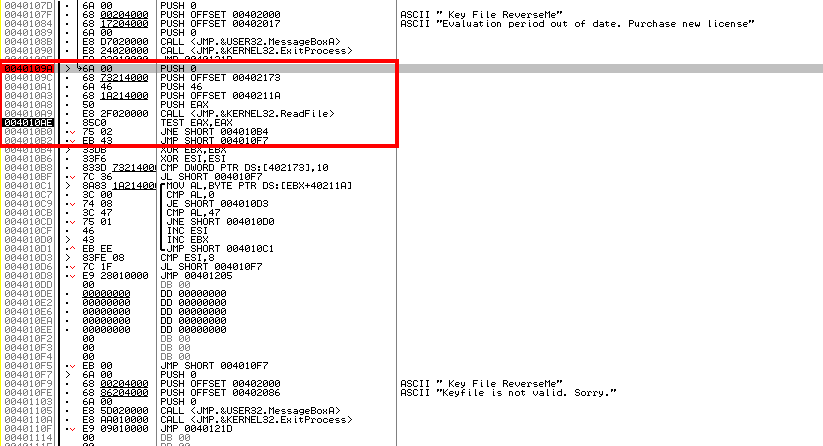
Jumping past the evaluation error message we land at 0x40109A where the stack is populated before a call to the ReadFile function, refer to figure 3, above. The windows API reference for ReadFile mentions that the function reads data from a specified position within a specified file or an input/output device. The function takes the following parameters:
- hFile (HANDLE): The handle to the file that needs to be read from,
- lpBuffer (LPVOID): The pointer to the buffer, a pointer that points to the location in memory where data to be stored temporarily,
- nNumberOfBytesToRead (DWORD): The amount of data (bytes) to be read.
- etc…
Looking at what is actually being pushed on to the stack before the ReadFile call, keeping in mind that the parameters are pushed in reverse order. We can see the following:
- lpOverlapped: 0 ,
- nNumberOfBytesRead: offset [00402173],
- nNumberOfBytesToRead : 46 hex (bytes),
- lpBuffer: offset [0040211A],
- hFile Handle: EAX
In reference to the Win32 API manual and the pushed parameters, we can identify that it tries to open a file using the handle in the EAX register, which was set by the CreateFileA call earlier. Then it reads a maximum of 46h (“h” for hex) or 70 bytes from the file and stores them at the location pointed by the lpBuffer ([0040211A]). Try adding some text in the “Keyfile.dat” you had created earlier and you should be able to view them in the memory/hex dump at lpBuffer location (40211A). For example, figure 3 - hex dump section. Keeping in mind that with CDECL calling convention it is standard to return values from a call in the EAX register.
Essentially the ReadFile function is called to read the serial key from the Keyfile.dat into the memory. Looking at it from a practical point of view, this function is being called to read the serial key from the “Keyfile.dat” file. The next operation “TEST EAX, EAX” conducts a logical AND operation on the returned value in the EAX register and sets the state of ZF based on the result. The win32 API manual mentions that if the function succeeds then it would return a true value, a non-zero value. Thus if the function returns a non-zero value then the TEST operation on a non zero value would be 1, see AND documentation. Based on this the ZF is set to 0 and vice versa for zero value. If you do a TEST (or an AND operation) on 0 and 0 the result would be 0 and the zero flag would be set to 1. In the next operation, JNE SHORT 04010B4, a jump will take place based on the ZF status. If the ZF equals to 0 then it would jump to 04010B4 and if it did not it would continue to the next instruction, JMP 4010F7, to an invalid license key error message. It is necessary to take the jump at JNE 0x004010B0 to avoid the invalid license error.
Figure 4: ReadFile - Test eax:eax = 1; zf=0, jmp taken

License Validation algorithm
Figure 5: License Validation Algorithm
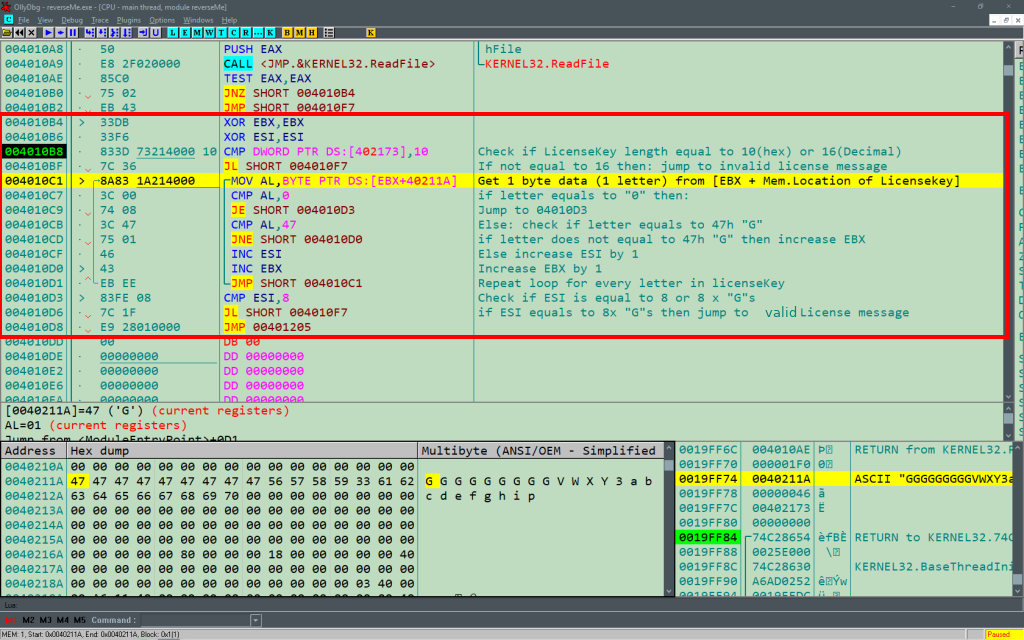
Successfully taking the jump at JNE after the Test operation, we land at 0x4010B4, and avoided the licensing error. This section may look chunky and complex. To get a sense of what it does we can use some basic analysis strategy. It is helpful to start by observing what this section of code does in general and then the specifics. We can do this by first taking a look where the jumps leads to and what sort of functions are called. Figure 6 shows an outline of the jumps. Referring to figure 6, below, to get to the flag or the success message we need to take the jump at 0x04010C8. Now having a rough idea of where jump instructions should be taken and avoided, we can take a closer look at the algorithm.
Figure 6: License Validation Algorithm Jump Outline
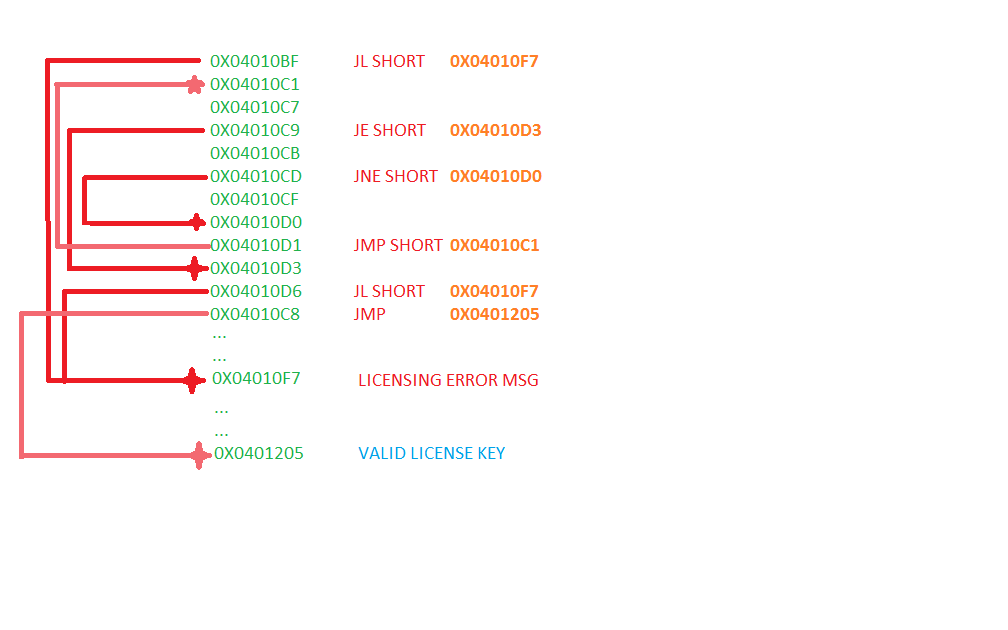
Starting from the beginning of the algorithm (0x04010B4). The first two instruction is XOR, or logical exclusive OR. It basically does the following: for each bits of the operands (EBX, EBX),
- if either are 1, the resulting bit is set to 1,
- if both are 1 the resulting bit is set to 0, and
- if both are 0, the resulting bit is also set to 0.
Since the XOR operands are the same the resulting bits would be 0. This clears the EAX register with 0s, it is cleared to have it prepared for future use.
Next, a CMP instruction. The CMP instruction compares “DWORD PTR DS:[0x0402173]” and 10h. The beginning of the first operand “DWORD”(Double Word) specifies the amount of data, 2 words (4 bytes or 32 bits) to be selected from the location pointed by “PTR DS:[0x0402173]”. If you remember from the ReadFile call, this address was passed as a parameter for nNumberOfBytesRead: offset [00402173]. In simple terms, the win32 api mentions that the total number of bytes read from the file will be stored at location pointed by nNumberOfBytesRead. The second operand is immediate/constant value, in Olly Debugger the immediate/constant values are presented in hex. Thus 10 hex in decimal would be 16. The total number of bytes read from the file is compared with 16 bytes or 16 characters. The next instruction is JL SHORT 0x04010F7. If the total number of bytes read from file is less than 16 bytes, or nNumberofBytesRead is less than 16 then the jump would be taken. The jump leads to invalid license error. This means that license key has to be 16 bytes long. Populate the license key created with random characters, preferably at least 16 characters.
The next instruction is: “MOV AL, BYTE PTR DS:[EBX+40211A]. The MOV instruction copies data from source to destination: MOV Destination, Source. The source/data to be copied is: BYTE PTR DS:[EBX+40211A]. BYTE PTR, specifies that 1 byte should be selected/copied from the DS (Data Segment) with the offset of [EBX+40211A]. We know that 0x40211A is the memory location that was passed as the buffer (lpBuffer) argument when the ReadFile was called. This is the location where the read data from license key is stored temporarily. EBX register was cleared or set to 0 at the beginning, so :[EBX=0 + 0x40211A] = 0x40211A. This points to the memory location at which the license key is stored, the first character of the license key. Basically it copies the first character of the license key to AL. AL is the lower 8 bits of the AX component of EAX register. Please refer to figure 7 and the basics if need to.
Figure 7: AX component/subsection of EAX register courtesy of c-jump.com
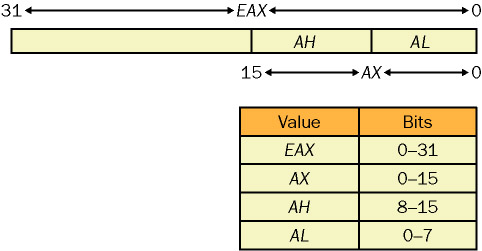
Next, “CMP AL,0”. The first character of the license key in AL is compared against 0h. Referring to a hex to ascii conversion table, 0 hex is 0 in ascii. Next, if AL equals to 0, the jump will take place, jumping to 0x04010D3. Where ESI is compared against 8h or 8 decimal. There if ESI was lower than 8, it jumps to invalid license error but if it equals or more than 8 it would jump to Valid license key message. However, if AL does not equal to 0, then it would INC (increase) EBX with 1 and then jump back up to 0x4010C1. There [EBX=1 + 0x40211A] = 2nd character of license key would be copied to AL. From this we can see that it is a loop that keeps checking each character of the license key. However, if the jump at 0x4010C9 does not take place then AL would be compared with 47h or “G” in ascii. If AL does not equal to “G” then it would continue to increase EBX by one and continue the loop. If AL does equal to “G” then it would increase ESI and EBX by 1. This loop will continue to occur until AL equals to 0. AL will equal to 0 if we reach the end of license key, as there are no data past the license key. From this we know that:
- the license key needs to be 16 bytes/characters long,
- it has to contain 8 * 47h or “G”, and
- there should be no 0s.
Now if you create a license key following the mentioned rules, you will be greeted with a valid license key message, or the flag of this crack me. Congratulations.
Figure 8: The Flag - Success Message
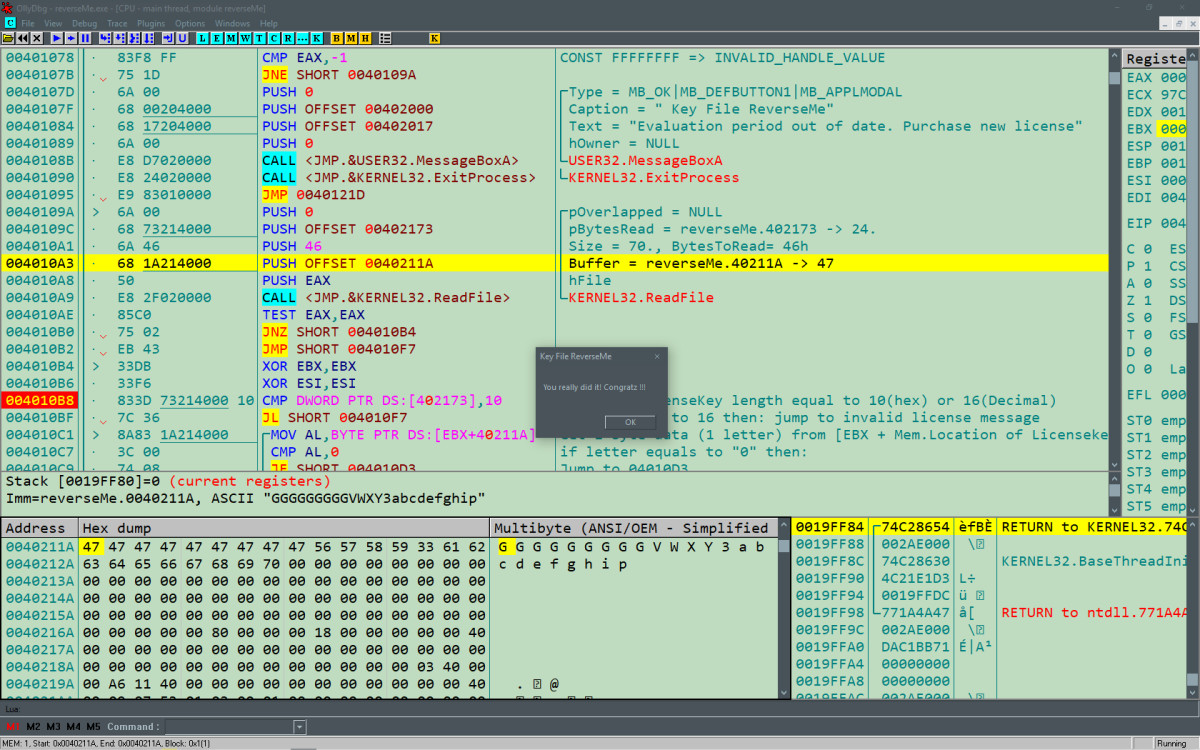
Useful Resource/s
Calling convention - ASM: Unixwiz
Found an error or like what you read?
Please navigate to About me page to get in touch. Thanks in advance.